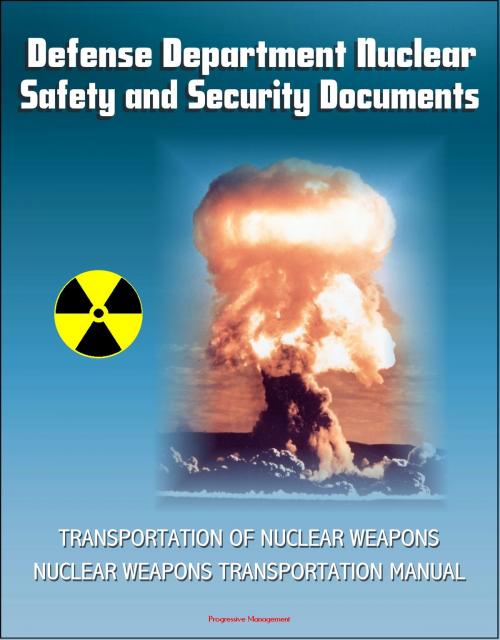Defense Department Nuclear Safety and Security Documents: Transportation of Nuclear Weapons, Nuclear Weapons Transportation Manual
Nonfiction, History, Military, Nuclear Warfare| Author: | Progressive Management | ISBN: | 9781301279647 |
| Publisher: | Progressive Management | Publication: | September 21, 2012 |
| Imprint: | Smashwords Edition | Language: | English |
| Author: | Progressive Management |
| ISBN: | 9781301279647 |
| Publisher: | Progressive Management |
| Publication: | September 21, 2012 |
| Imprint: | Smashwords Edition |
| Language: | English |
Four unclassified Department of Defense documents, approved for public release, provide information on procedures for transporting nuclear weapons.
Part 1: Logistic Transportation of Nuclear Weapons * Part 2: DoD Transportation of U.S. Nuclear Weapons * Part 3: DoD Nuclear Weapons Transportation Manual * Part 4: Air Transport Procedures - Transport Of W84 Nuclear Warhead In H1408 Container By US Army CH-47 Helicopter
It is DoD policy that: Nuclear weapons require special consideration because of their political and military importance and the potential consequences of an accident, incident, or unauthorized act. The DoD Components shall take precautions to ensure that a nuclear weapon movement has minimal impact on public health, safety, and the environment. DoD nuclear weapon system safety policy, DoD nuclear weapon system safety standards, and DoD nuclear weapon security policy and criteria shall apply to nuclear weapon transport operations. Nuclear weapon movements shall be kept to the minimum consistent with military requirements. Nuclear weapon transportation operations shall be conducted through the transportation modes and movement routes that balance safety, security, and military requirements. The movement by air of nuclear weapons that contain high explosives other than insensitive high explosives (IHE) should be approved by the Secretary of the Military Department or a Commander of a Combatant Command, or their delegated commanders. Procedures, equipment, and facilities involved in the transport of nuclear weapons shall be certified for such transport. Personnel and organizations involved in the transport of nuclear weapons shall be trained and certified for the activities they perform. U.S. custody of nuclear weapons shall be maintained at all times during logistic movements. That requirement shall not be waived. A commander may deviate from logistic transport policy when the loss of a weapon's custody is imminent or when the weapon may be exposed to an abnormal environment. In areas outside the continental United States, command-disable procedures shall be used if loss of the weapon is imminent.
DoD Nuclear Weapons Transportation Manual - This Manual provides guidance for the transport of nuclear weapons by the DoD Components, expands on the transportation policies and responsibilities and describes a range of transportation activities. It also addresses safety, security, and use control guidance for the transport of nuclear weapons.
Four unclassified Department of Defense documents, approved for public release, provide information on procedures for transporting nuclear weapons.
Part 1: Logistic Transportation of Nuclear Weapons * Part 2: DoD Transportation of U.S. Nuclear Weapons * Part 3: DoD Nuclear Weapons Transportation Manual * Part 4: Air Transport Procedures - Transport Of W84 Nuclear Warhead In H1408 Container By US Army CH-47 Helicopter
It is DoD policy that: Nuclear weapons require special consideration because of their political and military importance and the potential consequences of an accident, incident, or unauthorized act. The DoD Components shall take precautions to ensure that a nuclear weapon movement has minimal impact on public health, safety, and the environment. DoD nuclear weapon system safety policy, DoD nuclear weapon system safety standards, and DoD nuclear weapon security policy and criteria shall apply to nuclear weapon transport operations. Nuclear weapon movements shall be kept to the minimum consistent with military requirements. Nuclear weapon transportation operations shall be conducted through the transportation modes and movement routes that balance safety, security, and military requirements. The movement by air of nuclear weapons that contain high explosives other than insensitive high explosives (IHE) should be approved by the Secretary of the Military Department or a Commander of a Combatant Command, or their delegated commanders. Procedures, equipment, and facilities involved in the transport of nuclear weapons shall be certified for such transport. Personnel and organizations involved in the transport of nuclear weapons shall be trained and certified for the activities they perform. U.S. custody of nuclear weapons shall be maintained at all times during logistic movements. That requirement shall not be waived. A commander may deviate from logistic transport policy when the loss of a weapon's custody is imminent or when the weapon may be exposed to an abnormal environment. In areas outside the continental United States, command-disable procedures shall be used if loss of the weapon is imminent.
DoD Nuclear Weapons Transportation Manual - This Manual provides guidance for the transport of nuclear weapons by the DoD Components, expands on the transportation policies and responsibilities and describes a range of transportation activities. It also addresses safety, security, and use control guidance for the transport of nuclear weapons.















